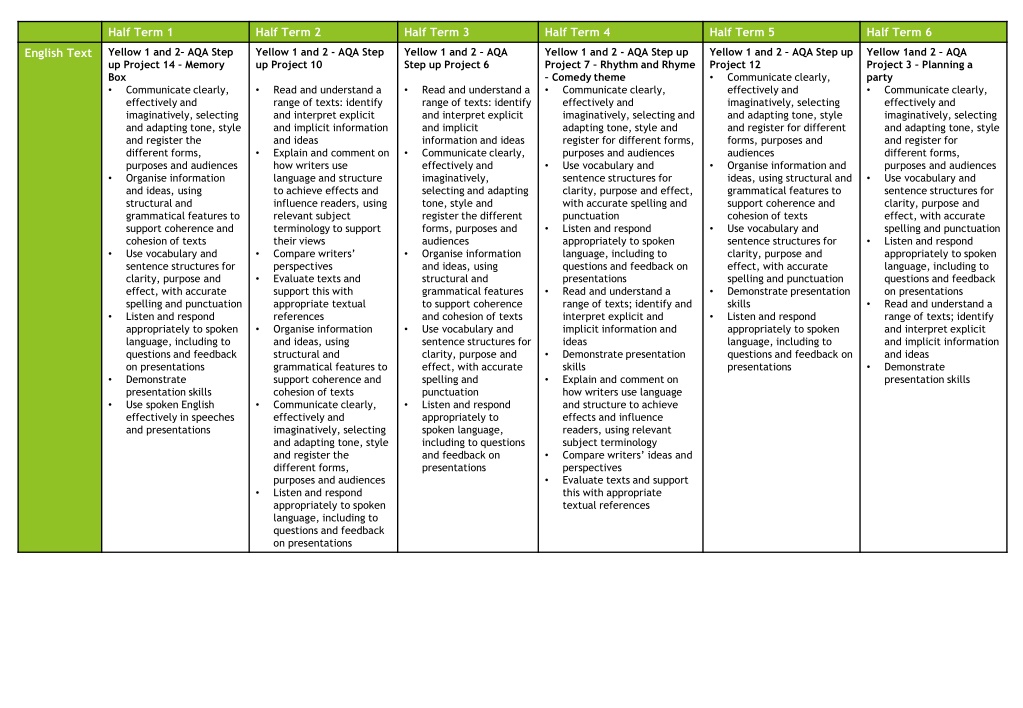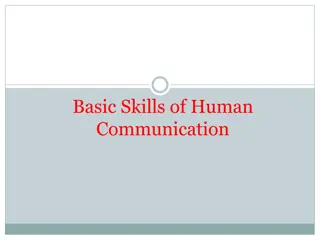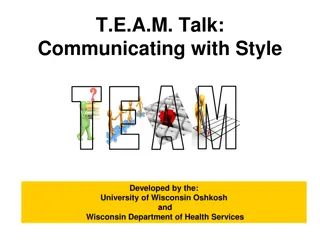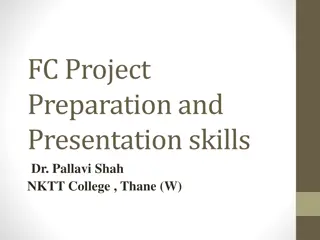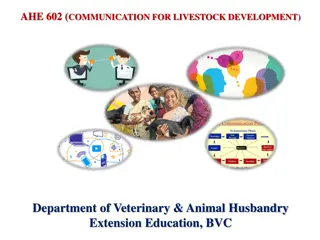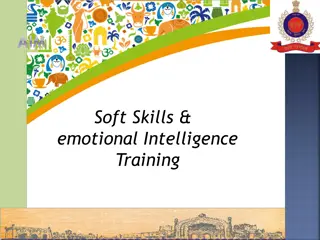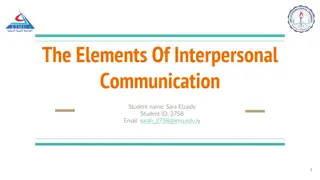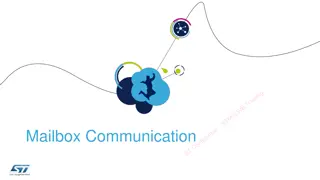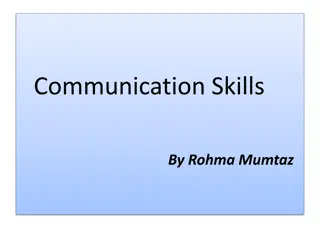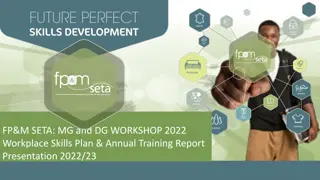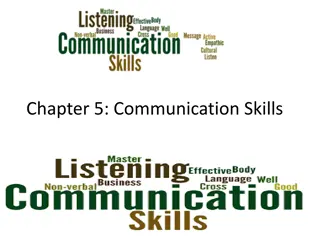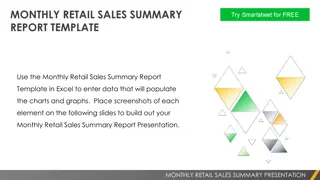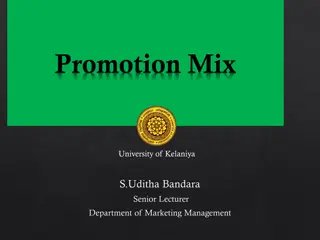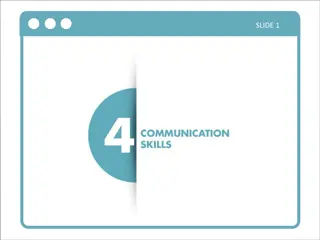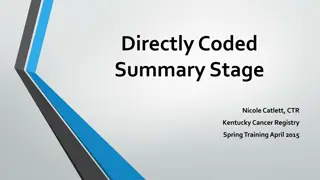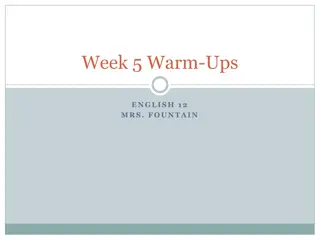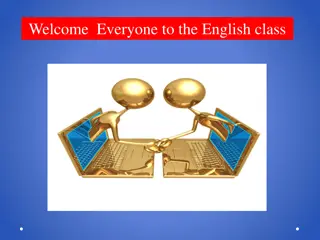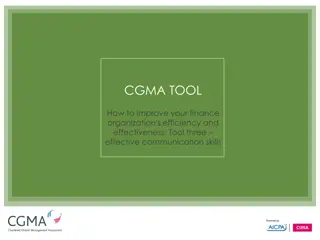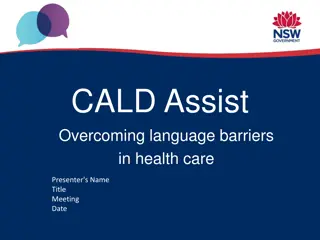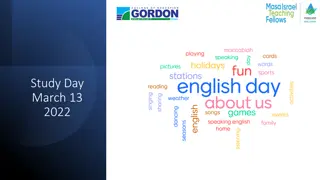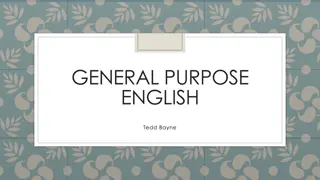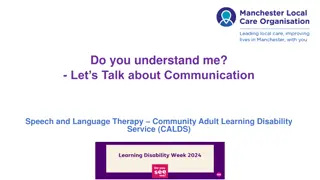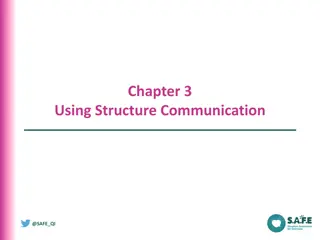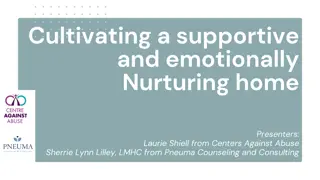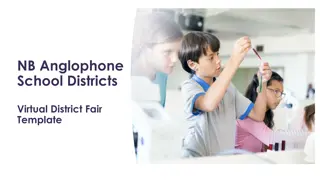Comprehensive English Communication and Presentation Skills Development Summary
Enhance English communication skills through various projects and activities focused on clarity, tone adaptation, vocabulary use, and presentation skills. Explore literary analysis, party planning, and comedy themes while improving coherence, cohesion, and textual interpretation. Develop proficiency in spoken and written English for diverse audiences and purposes.
- English language
- Communication skills
- Presentation techniques
- Literary analysis
- Vocabulary enhancement
Download Presentation

Please find below an Image/Link to download the presentation.
The content on the website is provided AS IS for your information and personal use only. It may not be sold, licensed, or shared on other websites without obtaining consent from the author. Download presentation by click this link. If you encounter any issues during the download, it is possible that the publisher has removed the file from their server.
E N D
Presentation Transcript
Half Term 1 Half Term 2 Half Term 3 Half Term 4 Half Term 5 Half Term 6 Yellow 1 and 2 AQA Step up Project 14 Memory Box Communicate clearly, effectively and imaginatively, selecting and adapting tone, style and register the different forms, purposes and audiences Organise information and ideas, using structural and grammatical features to support coherence and cohesion of texts Use vocabulary and sentence structures for clarity, purpose and effect, with accurate spelling and punctuation Listen and respond appropriately to spoken language, including to questions and feedback on presentations Demonstrate presentation skills Use spoken English effectively in speeches and presentations Yellow 1 and 2 - AQA Step up Project 10 Yellow 1 and 2 AQA Step up Project 6 Yellow 1 and 2 - AQA Step up Project 7 Rhythm and Rhyme Comedy theme Communicate clearly, effectively and imaginatively, selecting and adapting tone, style and register for different forms, purposes and audiences Use vocabulary and sentence structures for clarity, purpose and effect, with accurate spelling and punctuation Listen and respond appropriately to spoken language, including to questions and feedback on presentations Read and understand a range of texts; identify and interpret explicit and implicit information and ideas Demonstrate presentation skills Explain and comment on how writers use language and structure to achieve effects and influence readers, using relevant subject terminology Compare writers ideas and perspectives Evaluate texts and support this with appropriate textual references Yellow 1 and 2 AQA Step up Project 12 Communicate clearly, effectively and imaginatively, selecting and adapting tone, style and register for different forms, purposes and audiences Organise information and ideas, using structural and grammatical features to support coherence and cohesion of texts Use vocabulary and sentence structures for clarity, purpose and effect, with accurate spelling and punctuation Demonstrate presentation skills Listen and respond appropriately to spoken language, including to questions and feedback on presentations Yellow 1and 2 AQA Project 3 Planning a party Communicate clearly, effectively and imaginatively, selecting and adapting tone, style and register for different forms, purposes and audiences Use vocabulary and sentence structures for clarity, purpose and effect, with accurate spelling and punctuation Listen and respond appropriately to spoken language, including to questions and feedback on presentations Read and understand a range of texts; identify and interpret explicit and implicit information and ideas Demonstrate presentation skills English Text Read and understand a range of texts: identify and interpret explicit and implicit information and ideas Explain and comment on how writers use language and structure to achieve effects and influence readers, using relevant subject terminology to support their views Compare writers perspectives Evaluate texts and support this with appropriate textual references Organise information and ideas, using structural and grammatical features to support coherence and cohesion of texts Communicate clearly, effectively and imaginatively, selecting and adapting tone, style and register the different forms, purposes and audiences Listen and respond appropriately to spoken language, including to questions and feedback on presentations Read and understand a range of texts: identify and interpret explicit and implicit information and ideas Communicate clearly, effectively and imaginatively, selecting and adapting tone, style and register the different forms, purposes and audiences Organise information and ideas, using structural and grammatical features to support coherence and cohesion of texts Use vocabulary and sentence structures for clarity, purpose and effect, with accurate spelling and punctuation Listen and respond appropriately to spoken language, including to questions and feedback on presentations
Half Term 1 Half Term 2 Half Term 3 Half Term 4 Half Term 5 Half Term 6 Yellow 1 Billionaire Boy by David Walliams Yellow 1 and 2 Flat Stanley by Jeff Brown Letter Writing Yellow 1 A Midsummer Night s Dream Yellow 1 and 2 - Poetry English Literature Yellow 2 George's Marvellous Medicine by Roald Dahl Yellow 2 Hamlet Shakespeare Reading Maintain positive attitudes to reading and an understanding of what have read by - Continuing to read and discuss an increasing wide range of fiction - Reading books that are structured in different ways and reading for a range of purposes - Increasing their familiarity with a wide range of books, including myths, legends and traditional stories, modern fiction, fiction from our literary heritage, and books from other cultures and traditions - Identifying and discussing themes and conventions in and across a wide range of writing - Making comparisons within and across books - Asking questions to improve their understanding - Checking that the book makes sense to them, discussing their understanding and exploring the meaning of words in context - Predicting what might happen from details stated and implied - Identifying how language, structure and presentation contribute to meaning - Participate in discussions about books that are read to them and those that can read for themselves, building on their own and other s ideas and challenging views courteously - Preparing poems and play scripts to read aloud and to perform, showing understanding through intonation, tone, volume and action Writing transcription Use dictionaries to check the spelling and meaning of words Use the first 3 or 4 letters of a word to check spelling, meaning or both of these in a dictionary Use a thesaurus Handwriting and presentation Write legibly, fluently and with increasing speed Writing Composition Plan their writing by - Identifying the audience for and purpose of the writing, selecting the appropriate form and using other similar writing as models for their own - Noting and developing initial ideas, drawing and reading and research where necessary - In writing narratives, considering how authors have developed characters and settings in what pupils have read, listened to or seen performed Draft and write by - Selecting appropriate grammar and vocabulary, understanding how such choices can change and enhance meaning - In narratives, describing settings, characters and atmosphere and integrating dialogue to convey character and advance the action
Yellow 1 and 2 Place Value, sequencing and order Count to and across 100, forwards and backwards from any given number Count, read and write numbers to 100 in numerals Use language of: equal to, more than, less than (fewer), most, least Given a number, identify one more or less than Recognise the place value of each digit in a two-digit number Yellow 1 and 2 Addition and Subtraction Add and subtract numbers using concrete objects, pictorial representations, and mentally, including : a two-digit number and ones, a two-digit numbers and tens, two two-digit numbers, adding three- digit numbers Recall and use addition and subtraction facts to 20 fluently, and derive and use related facts up to 100 Yellow 1 and 2 Multiplication and Division Recall and use multiplication and division facts for the 2,5 and 10 multiplication tables Solve problems involving multiplication and division (including those with remainders), using materials, arrays, repeated addition, mental methods, and multiplication and division facts, including problems in contexts Show that multiplication of two numbers can be done in any order (commutative) and division of one number by another cannot Yellow 1 and 2 Statistics Interpret and construct simple pictograms, tally charts, block diagrams and simple tables Sort objects, numbers and shapes to a given criterion and their own Yellow 1 and 2 Fractions, Percentages and decimals Understand that a fraction can describe part of a set Recognise, find, name and write fractions 1/3, , 2/4 and of a length, shape, set of objects or quantity Understand the larger the denominator is, the more pieces it is split into and therefore the smaller each part will be recognise the per cent symbol (%) and understand that per cent relates to number of parts per hundred and write percentages as a fraction with denominator 100 Yellow 1 and 2 Four functions Revision of previous objectives related to each of the four functions Maths Number skills Yellow 1 Length and height Choose and use appropriate standard units to estimate and measure Compares and orders lengths and records the results using <,> and = Yellow 1 Position and Direction Describe position, direction and movement, including whole, half, quarter and three-quarter turns Order and arrange combinations of mathematical objects in patterns and sequences Describe positions on a 2-D grid as co-ordinates in the first quadrant Yellow 1 Time Compare and sequence intervals of time Tell and write time to five minutes, including quarter past/to the hour and draw hands on clock Yellow 1 Money Recognise and use symbols for pounds and pence; combine amounts to make a particular value, find different combinations of coins that equal the same amount of money, give change Yellow 1 Mass and Capacity Choose and use appropriate standard units to estimate and measure Compares and orders lengths, mass, volume/capacity and records the results using <,> and = Yellow 1 2D and 3D shape Identify and describe the properties of 2D and 3D shapes, including the numbers of sides and line of symmetry in a vertical line Identify 2D shapes on the surface of 3D shapes Compare and sort common 2D and 3D shapes and everyday objects Yellow 2 - Mass and Capacity Choose and use appropriate standard units to estimate and measure Compares and orders lengths, mass, volume/capacity and records the results using <,> and = Maths - topic Yellow 2 Money Recognise and use symbols for pounds and pence; combine amounts to make a particular value, find different combinations of coins that equal the same amount of money, give change Yellow 2 2D and 3D shape Identify and describe the properties of 2D and 3D shapes, including the numbers of sides and line of symmetry in a vertical line Identify 2D shapes on the surface of 3D shapes Compare and sort common 2D and 3D shapes and everyday objects Yellow 2 Position and Direction Describe position, direction and movement, including whole, half, quarter and three-quarter turns Order and arrange combinations of mathematical objects in patterns and sequences Describe positions on a 2-D grid as co- ordinates in the first quadrant Yellow 2 Time Compare and sequence intervals of time Tell and write time to five minutes, including quarter past/to the hour and draw hands on clock Yellow 2 - Length and height Choose and use appropriate standard units to estimate and measure Compares and orders lengths and records the results using <,> and =
Yellow 1 and 2 Colour Mixing Yellow 1 and 2 Sculpture Yellow 1 and 2 Colour Mixing Yellow 1 and 2 Pencil drawing Yellow 1 and 2 - Photography Yellow 1 and 2 Critiquing art work Art / D.T./ Food Technology Intentionally represent an object or image Communicate ideas through their use of colour, form, line and tone Use a growing art vocabulary Show confidence in using a variety of processes and make appropriate use of tools and materials Improve mastery of art and design technique Understand about the history of art, including periods, styles and major movements Develop the creative, technical and practical expertise needed to perform everyday tasks confidently and to participate fully in an increasingly technological world Use research and exploration, such as a study of different cultures, to identify and understand user needs Yellow 1 and 2 - Word, Font, cutting pasting, saving and retrieving Opening Saving Retrieving Editing Changing font (type, size and colour). Copying and pasting. Yellow 1 and 2 - Internet Safety To develop an understanding of all the ways in which we use the internet. Use technology safely, respectfully and responsibly. Recognise acceptable/unacceptable behaviour. Identify a range of ways to report concerns about content and contact. Yellow 1 and 2 - Stop motion and movie making Undertake creative projects that involve selecting, using and combining multiple applications, preferably across a range of devices, to achieve challenging goals. To use these skills in order to produce both stop motion animation and live action movies. Editing of these movies. Yellow 1 and 2 - Computer programming To learn some basic computer programming functions. To build and design Lego robots which can then be programmed using a range of functions/controls. Yellow 1 and 2 - Coding Use the repeat command within a series of instructions. Use conditional statements. Use a variety of inputs. Computing
Yellow 1 and 2 Earth and Space Have a basic understanding of the concept of space and our place in the universe. Know what is meant by the solar system, to include the order of the planets from the sun. Be aware of the different components of the planets, including their relative sizes, densities and atmospheres. Understand why we get: day & night, years and the 4 seasons and why these differ on different planets as well as at different points on the Earth s surface. Understand the phases of the moon and how these cause tides. Know the structure of the Earth, including its core, the mantle and tectonic plates. Understand how movement of tectonic plates causes earthquakes, tsunamis and volcanoes. Know the different layers of the Earth s atmosphere. Yellow 1 and 2 Electricity and Magnetism Know the uses and dangers of electricity. Be aware of the different components of an electrical circuit. know the difference between series and parallel circuits. Have a basic understanding of current and voltage. Know that magnets have a north and a south pole. Understand that opposite poles attract and like poles repel. Know what is meant by a magnetic field and the effects of this. Understand what electromagnets are and how the strength of these can be altered. Know some uses of permanent magnets and electromagnets in everyday life. Yellow 1 and 2 Energy Know that energy can neither be created nor destroyed. Understand that energy transfers occur to convert one form of energy into another. Know some examples of energy transfers that occur on our every day lives. Be aware of ways in which we can increase energy efficiency. Yellow 1 and 2 Microbes and Diseases Know that diseases can be caused by pathogenic microbes. Understand ways in which we can prevent the spread of disease. Know what antibiotics are, how they work and the dangers of overusing them. Be aware of how our immune system works. Know what vaccinations are and how they work. Science Yellow 1 and 2 People of Faith What religious people inspire you and your life choices? Yellow 1 and 2 Christmas What is the real message of Christmas? Yellow 1 and 2 Relating to each other How should we treat one another? Yellow 1 and 2 Journeys Why do people make pilgrimages and religious journeys? Yellow 1 and 2 God vs science Can God and scientific beliefs exist together? Yellow 1 and 2 How do we care for our world? How do religious and non- religious beliefs help inspire us to help the planet? RE Respecting all religions and others beliefs Important customs and festivals Special books and buildings Related symbols Communicate simple facts about religion and important people Identify a key belief of a religion Know we all make decisions about how we live Make simple comparisons between the different religions Know we all make decisions about how we live
Yellow 1 and 2 Ancient Greece Understand historical concepts such as continuity and change, cause and consequence Understand methods of historical enquiry Know and understand significant aspects of the history of the wider world; the nature of ancient civilisations Know and understand the expansion and dissolution of empires Gain and deploy a historically grounded understanding of abstract terms such as empire and civilisation Yellow 1 and Yellow 2 - Invaders Understand changes in Britain from the Stone Age to the Iron Age Gain knowledge of the Roam Empire and its impact on Britain Gain knowledge of Britain s settlement by Anglo- Saxons and Scots Develop knowledge of the Vikings and Anglo-Saxons Develop understanding of the development of Church, state and society in Britain Understand how people s lives have shaped the nation and how Britain has influences and been influenced by the wider world Know and understand the expansion and dissolution of empires Gain and deploy a historically grounded understanding of abstract terms such as empire and civilisation Yellow 1 and 2 Famous Leaders Gain knowledge if significant individuals in the past who have contributed to nationals and international achievements Compare aspects of life in different periods Learn about significant historical events, people and places in their own locality Know and understand the history of these islands as a coherent, chronological narrative Understand how people s lives have shaped the nation and how Britain has influences and been influenced by the wider world History Yellow 1 and 2 Mapping Locate the world s countries, using maps to focus on Europe and North and South America Name and locate countries and cities of the United Kingdom, geographical regions and their identifying human and physical characteristics Describe and understand key aspects of physical geography; human geography, including types of settlement and land use, economic activity Use maps, atlases, globes and digital/computer mapping to locate countries and describe features studied Yellow 1 and 2 Safari Describe and understand key aspects of physical geography; human geography, including types of settlement and land use, economic activity Understand their locational knowledge and deepen their spatial awareness of the world s countries using aps of the world to focus on Africa. Understand how human and physical processes interact to influence and change landscapes, environments and the climate; and how human activity relies on effective functioning of natural systems Yellow 1 and 2 Seaside Describe and understand key aspects of human and physical processes interact to influence and change landscapes, environments and the climate; and how human activity relies on effective functioning of natural systems including energy, food, minerals and water Describe and understand key aspects of physical geography; human geography, including types of settlement and land use, economic activity Geography Yellow 1 and 2 - Maps Be able to read maps Understand keys on maps Understand local maps Be able to make maps Yellow 1 and 2 - Navigation and Community Skills Be able to follow a route Understand where to get help Know key places in our environment Yellow 1 and 2 -Team Building: Take part in problem solving games Participate in communication games Participate in team Games Yellow 1 and 2 - Campsite Skills Learn how to set up tents Experience making tea outside Know the importance of storing food correctly Learn basic first aid Learn how to wash up Yellow 1 and 2 - Outdoor Cooking Safely use outdoor stoves Using campfire safely Prepare fferent meals/foods Planning meals Yellow 1 and 2 -Trip Planning Plan a destination Complete Risk assessing Working out costs and timings Planning travel Duchess of Ely
Yellow 1 and 2 Managing Feelings: Romantic feelings and sexual attraction Understand we can like people from any gender, race etc Understand which terms are suitable and appropriate to use when talking about sexual orientation Know where to go for advice Yellow 1 and 2 Self- awareness; Prejudice and discrimination and unkind comments Know what prejudice is and why it is unacceptable Know how to respond to prejudice and discrimination constructively Understand the importance of showing respect to other people s beliefs Understand the harm of stereotyping Yellow 1 and 2 Healthy lifestyles: Medicinal drugs and healthy eating Know what a healthy and balanced diet is Understand which food we can eat a lot of and which ones we should have as a treat Know what medicine is used for Know how to use medicinal drugs safely Understand the risks of taking drugs Know the benefits of healthy exercise Yellow 1 and 2 The world I live in: Preparing for adulthood Understand the range of jobs people do Understand how adults finance their lives Consider jobs they would like to do in the future Yellow 1 and 2 Changing and Growing: Puberty What physical changes happen during puberty? What aspects of personal hygiene we can take responsibility for What are the functions of the reproductive organs? What are the different stages of reproductions, pregnancy and birth? Yellow 1 and 2 Support and Safety: Accidents and risk Understand the difference between risk and danger Consider which situations can be risky Know how to reduce risk Know when it is positive to take a risk Online safety PSHE Yellow 1 and 2 Team Games Tag rugby or Netball Swimming Gym Communication and listening Team work Tactical thinking Persistence and resilience Skills progression Leadership Water safety Muscle fitness with safety Yellow 1 and 2 Fitness or multi-skills Swimming Gym Communication and listening Healthy lifestyle Body changes Persistence and resilience Motivation Improvement and progression Water safety Muscle fitness with safety Yellow 1 and 2 Yoga Swimming Gym Communication and listening Team work Gross and fine motor skills Skills progression and sequencing Persistence and resilience Creative and planning Water safety Muscle fitness with safety Yellow 1 and 2 Manage career Identify key points in the career journey of a role model parent, celebrity, sports star Learn about people who have had multiple careers Write an application for a school role and identify why suitable Identify ways of making positive transitions Know how to make and adapt plans and decisions but understand plans can change and may need a backup plan Yellow 1 and 2 Cricket or Rounders Communication and listening Team work Gross and fine motor skills Skills progression and sequencing Persistence and resilience Creative and planning Water safety Muscle fitness with safety Yellow 1 and 2 Leadership games or athletics Communication and listening Team work Tactical thinking Persistence and resilience Skills progression Leadership Water safety Muscle fitness with safety Yellow 1 and 2 Tennis or Handball Communication and listening Team work Gross and fine motor skills Persistence and resilience Skills progression Leadership Planning and evaluating Sportsmanship Water safety Muscle fitness with safety Yellow 1 and 2 See the big picture Explore the role of TV, internet, the press and other media in portraying careers Describe a local business, how it is run and the products and/or services it provides Identify jobs that are more in demand or have been created because of advances in technology Learn about ways id carrying out shared responsibilities, e.g. becoming an eco- warrior PE Yellow 1 and 2 Grow throughout life Know how to find out about their future Understand how to use skills and abilities to support their success Describe their qualities Know how to achieve something that is important to them Recognise the harm of stereotyping and discrimination and the importance of treating people fairly Yellow 1 and 2 Explore possibilities Be aware of the main sectors of employment in area- past, present and emerging Understand some jobs require skills and how to gain these through apprenticeship, college or university Know the importance of making a good impression and how this an be achieved Yellow 1 and 2 Create opportunities Understand the importance of teamwork and how it helps an environment Compare information about choices open to them and be able to voice preferences Face challenges positively by gathering information and seeking help Understand different roles in a team and understand the leader doesn t need to make all the decisions Use initiative and be enterprising Yellow 1 and 2 Balance life and work Be aware of how to keep safe, both physically and mentally Show how to make considered decisions about saving, spending and giving Understand what a charity is and how charities can create change Recognise that there are human rights and responsibilities and that they are to protect everyone Be empathetic and socially conscious towards others Careers
